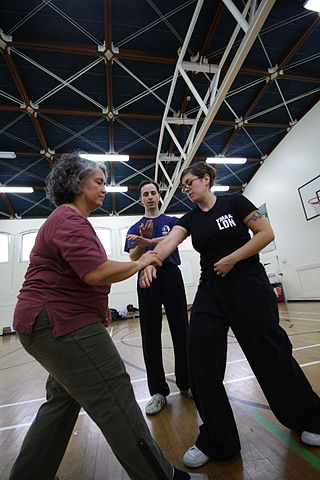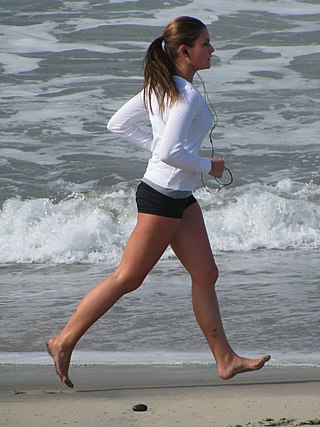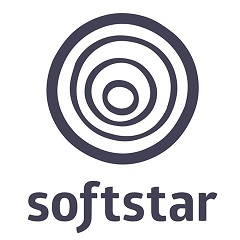Related Research Articles

The foot is an anatomical structure found in many vertebrates. It is the terminal portion of a limb which bears weight and allows locomotion. In many animals with feet, the foot is a separate organ at the terminal part of the leg made up of one or more segments or bones, generally including claws and/or nails.

Running is a method of terrestrial locomotion by which humans and other animals move rapidly on foot. Running is a gait with an aerial phase in which all feet are above the ground. This is in contrast to walking, where one foot is always in contact with the ground, the legs are kept mostly straight, and the center of gravity vaults over the stance leg or legs in an inverted pendulum fashion. A feature of a running body from the viewpoint of spring-mass mechanics is that changes in kinetic and potential energy within a stride co-occur, with energy storage accomplished by springy tendons and passive muscle elasticity. The term "running" can refer to a variety of speeds ranging from jogging to sprinting.

Long-distance running, or endurance running, is a form of continuous running over distances of at least 3 km (1.9 mi). Physiologically, it is largely aerobic in nature and requires stamina as well as mental strength.

Cheng Man-ch'ing or Zheng Manqing was a Chinese expert of tai chi, Chinese medicine, and the so-called three perfections: calligraphy, painting and poetry. He was born in Yongjia, Zhejiang Province, during the Qing dynasty. Cheng died March 26, 1975; his grave is near the city of Taipei in Taiwan.

Road running is the sport of running on a measured course over an established road. This differs from track and field on a regular track and cross country running over natural terrain.

Pushing hands, Push hands or tuishou is a two-person training routine practiced in internal Chinese martial arts such as baguazhang, xingyiquan, tai chi, and yiquan. It is also played as an international sport akin to judo, sumo and wrestling, such as in Taiwan, where the biannual Tai Chi World Cup is held.

Emil Zátopek was a Czech long-distance runner best known for winning three gold medals at the 1952 Summer Olympics in Helsinki. He won gold in the 5,000 metres and 10,000 metres runs, but his final medal came when he decided at the last minute to compete in the first marathon of his life. He was nicknamed the "Czech Locomotive".
Catherina McKiernan is a former long-distance runner from Ireland, who competed in the marathon, 10,000 metres and cross country running.

A gait is a manner of limb movements made during locomotion. Human gaits are the various ways in which humans can move, either naturally or as a result of specialized training. Human gait is defined as bipedal forward propulsion of the center of gravity of the human body, in which there are sinuous movements of different segments of the body with little energy spent. Various gaits are characterized by differences in limb movement patterns, overall velocity, forces, kinetic and potential energy cycles, and changes in contact with the ground.

Taoist tai chi is a form of tai chi which is taught in more than 25 countries by the non-profit International Taoist Tai Chi Society and associated national Taoist Tai Chi societies. It is a modified form of Yang-style tai chi developed by Taoist monk Moy Lin-shin in Toronto, Ontario, Canada. Moy incorporated principles of Liuhebafa and other internal arts to increase the health benefits of practising the form.

Yang Shaohou was a Chinese martial arts master who, along with Yang Chengfu, represents the third generation of Yang-style tai chi. Grandmaster of his generation and known for his compact "small-frame" techniques, he was a ferocious fighter and a demanding teacher.
Racing flats, or simply flats, are lightweight athletic shoes designed for "long distance" track and field, cross country, and most often, road races. They differ from normal training shoes mainly by the lack of a substantial heel to toe drop.

Barefoot running, also called "natural running", is the act of running without footwear. With the advent of modern footwear, running barefoot has become less common in most parts of the world but is still practiced in parts of Africa and Latin America. In some Western countries, barefoot running has grown in popularity due to perceived health benefits.

Pronation is a natural movement of the foot that occurs during foot landing while running or walking. Composed of three cardinal plane components: subtalar eversion, ankle dorsiflexion, and forefoot abduction, these three distinct motions of the foot occur simultaneously during the pronation phase. Pronation is a normal, desirable, and necessary component of the gait cycle. Pronation is the first half of the stance phase, whereas supination starts the propulsive phase as the heel begins to lift off the ground.

The Vibram FiveFingers are a type of minimalist shoe manufactured by Vibram, originally marketed as a more natural alternative for outdoor activities. The footwear is meant to replicate being barefoot and has thin, flexible soles that are contoured to the shape of the human foot, including visible individual sections for the toes. The company settled a lawsuit in 2014 alleging false health claims and set aside $3.75 million to pay refunds of up to $94 to anyone who had purchased the product since March 21, 2009.

Locomotor effects of shoes are the way in which the physical characteristics or components of shoes influence the locomotion neuromechanics of a person. Depending on the characteristics of the shoes, the effects are various, ranging from alteration in balance and posture, muscle activity of different muscles as measured by electromyography (EMG), and the impact force. There are many different types of shoes that exist, such as running, walking, loafers, high heels, sandals, slippers, work boots, dress shoes, and many more. However, a typical shoe will be composed of an insole, midsole, outsole, and heels, if any. In an unshod condition, where one is without any shoes, the locomotor effects are primarily observed in the heel strike patterns and resulting impact forces generated on the ground.

A rocker sole shoe or rocker bottom shoe is a shoe that has a thicker-than-normal sole with a rounded heel. Such shoes ensure the wearer does not have flat footing along the proximal-distal axis of the foot. The shoes are generically known by a variety of names, including round bottom shoes, round/ed sole shoes, and toning shoes, but also by various brand names. Tyrell & Carter identified at least six standard variations of the rocker sole shoe and named them: toe-only rocker, rocker bar, mild rocker, heel-to-toe rocker, negative heel rocker and double rocker.

Cross country running shoes are made for cross country running, a form of long distance running. Season-specific trainers are available for different types of training.

Softstar Shoes is an American shoe manufacturer and retailer based in Philomath, Oregon. It is known for its minimalist or barefoot-style shoes and has been recognized as an early participant in the movement to encourage minimalist footwear.
Running injuries affect about half of runners annually. The frequencies of various RRI depend on the type of running, such as speed and mileage. Some injuries are acute, caused by sudden overstress, such as side stitch, strains, and sprains. Many of the common injuries that affect runners are chronic, developing over longer periods as the result of overuse. Common overuse injuries include shin splints, stress fractures, Achilles tendinitis, Iliotibial band syndrome, Patellofemoral pain, and plantar fasciitis.
References
- 1 2 Aubrey, Allison (September 14, 2006). "Chi Runners Poised for Softer Landings". NPR. Retrieved December 20, 2012.
- 1 2 Carol, Motsinger (June 18, 2012). "Motsinger: Columnist shares her course to complete the Asheville Citizen-Times; Half-Marathon Columnist will share her journey in trying to become a half-marathon runner". Citizen-Times. Asheville, North Carolina. Retrieved December 20, 2012.
- 1 2 3 Fitzgerald, Matt (May 5, 2009). "Can Running Technique Be Taught?". Competitor. Competitor Group, Inc. Retrieved December 20, 2012.
- 1 2 3 Parker-Pope, Tara (June 26, 2012). "WELL; New Emphasis on Running Style to Limit Injuries". The New York Times. New York. Retrieved December 21, 2012.
- 1 2 "Medical Advisory Board - Chi Running". www.chirunning.com. Retrieved 2018-02-02.
- ↑ Davis, Jeanie Lerche. Grayson Mathis, Charlotte (ed.). "Mindful Chi Running". WebMD. WebMD, LLC. Retrieved December 20, 2012.
- 1 2 Seven, Richard (November 17, 2008). "ChiRunning aligns body and mind". The Seattle Times. Seattle. Retrieved December 21, 2012.
- 1 2 Olmsted, Larry (August 21, 2012). "Run Further, Faster - And Pain Free. Does Chi Running Work?". Forbes. Retrieved December 21, 2012.